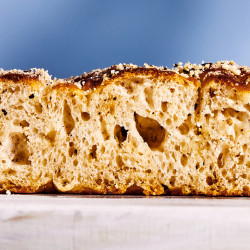Mix 3 cups (375 g) all-purpose flour, 2 oz. Pecorino Romano, finely grated (about ½ cup; 56 g), 2½ tsp. Diamond Crystal or 1½ tsp. Morton kosher salt, 2 tsp. sugar, 2 tsp. coarsely ground pepper, and ½ tsp. instant yeast in a large bowl with a rubber spatula to combine. Pour in 1⅓ cups room-temperature water and mix until a sticky dough forms with no dry patches of flour remaining. Cover tightly with a lid or plate and let rest at room temperature 15 minutes.
Uncover dough and, using a wet hand, stretch one side up and over to meet the opposite side. Repeat three more times, turning bowl 90° after each time. This constitutes 1 full fold. If dough doesn’t always stretch to meet opposite side, just aim for the middle. Wet your hands and shake off excess any time the dough begins to feel sticky. (Having a small bowl of room-temperature water on the counter is the easiest approach.) Cover dough and let rest 15 minutes. (Set a timer so you don’t forget.)
Repeat folding process every 15 minutes for a total of three times (if you lose count halfway through, just fold one more time and proceed). By the end of the third fold, the dough should be significantly smoother and tighter.
Drizzle dough with some extra-virgin olive oil and turn to coat. Turn dough seam side down, cover bowl tightly, and chill at least 8 hours and up to 1 day. Dough will rise slowly in the fridge, increasing in size, but may not double. (Alternatively, let dough rise, tightly covered, at room temperature, until nearly doubled in size, 3–4 hours.)
Generously butter a 10"–12" cast-iron skillet; pour 3 Tbsp. extra-virgin olive oil into skillet, swirling to coat (this double greasing prevents any sticking and helps create a golden brown bottom crust). Transfer dough to prepared skillet, turning to coat on all sides with oil. Turn dough seam side down. Using your fingers, press dough to edges of skillet. If dough resists, let rest 5–10 minutes before trying again. Cover skillet (a rimmed baking sheet is excellent for this) and let dough rise in a warm place until puffy, jiggly, and nearly doubled in size, 2–3 hours, depending on the temperature of the room.
Place a rack in middle of oven; preheat to 450°. Holding fingers like a claw, dimple focaccia, pushing dough slightly away from you to create deep depressions (this feels fun, but try not to overdo it or you’ll risk deflating the dough). Sprinkle surface with a large pinch of flaky sea salt.
Bake focaccia until puffed and deep golden brown (an instant-read thermometer inserted into the center should register 200°–205°), 20–30 minutes.
Meanwhile, mix remaining 1 oz. Pecorino Romano, finely grated (about ¼ cup; 29 g), and remaining ½ tsp. coarsely ground pepper in a small bowl to combine.
Slide focaccia out of oven; brush with remaining 1 Tbsp. extra-virgin olive oil and sprinkle cheese mixture evenly over. Return focaccia to oven and bake until cheese is just melted, about 2 minutes. Let focaccia cool in pan on a wire rack 5 minutes. Using a fish spatula or 2 large spoons, remove focaccia from pan and transfer to rack. Let cool at least 15 minutes, then slice into squares or wedges. Do Ahead: Focaccia can be baked 1 day ahead. Store, uncut, covered with a kitchen towel, at room temperature. Reheat in a 300° oven, or toast slices in a dry skillet over medium heat.
